Fabrication and Packaging of CMUT Using Low Temperature Co-Fired Ceramic
Abstract
:1. Introduction
2. Materials and Methods
2.1. Fabrication
2.2. Packaging
3. Results
4. Discussion
5. Conclusions
Author Contributions
Acknowledgments
Conflicts of Interest
References
- Khuri-Yakub, B.T.; Oralkan, O. Capacitive micromachined ultrasonic transducers for medical imaging and therapy. J. Micromech. Microeng. 2011, 21, 54004–54014. [Google Scholar] [CrossRef] [PubMed]
- Oralkan, O.; Ergun, A.S.; Johnson, J.A.; Karaman, M.; Demirci, U.; Kaviani, K.; Lee, T.H.; Khuri-Yakub, B.T. Capacitive Micromachined Ultrasonic Transducers: Next-Generation Arrays for Acoustic Imaging. IEEE Trans. Ultrason. Ferroelect. Freq. Control 2002, 49, 1596–1610. [Google Scholar] [CrossRef]
- Lohfink, A.; Eccardt, P.-C. Linear and nonlinear equivalent circuit modeling of CMUTs. IEEE Trans. Ultrason. Ferroelectr. Freq. Control 2005, 52, 2163–2172. [Google Scholar] [CrossRef] [PubMed]
- Köymen, H.; Şenlik, M.N.; Alar, A.A.; Olcum, S. Parametric linear modeling of circular CMUT membranes in vacuum. IEEE Trans. Ultrason. Ferroelectr. Freq. Control 2007, 54, 1229–1239. [Google Scholar] [CrossRef] [PubMed] [Green Version]
- Oleum, S.; Senlik, M.N.; Bayram, C.; Atalar, A. Design charts to maximize the gain-bandwidth product of capacitive micromachined ultrasonic transducers. Proc. IEEE Ultrason. Symp. 2005, 4, 1941–1944. [Google Scholar]
- Bayram, C.; Olcum, S.; Senlik, M.N.; Atalar, A. Bandwidth improvement in a CMUT array with mixed sized elements. Proc. IEEE Ultrason. Symp. 2005, 4, 1956–1959. [Google Scholar]
- Koymen, H.; Atalar, A.; Guler, S.; Koymen, I.; Tasdelen, A.S.; Unlugedik, A. Unbiased Charged Circular CMUT Microphone: Lumped-Element Modeling and Performance. IEEE Trans. Ultrason. Ferroelectr. Freq. Control 2018, 65, 60–71. [Google Scholar] [CrossRef] [PubMed]
- Jallouli, A.; Kacem, N.; Bourbon, G.; le Moal, P.; Walter, V.; Lardies, J. Pull-in instability tuning in imperfect nonlinear circular microplates under electrostatic actuation. Phys. Lett. Sect. A Gen. At. Solid State Phys. 2016, 380, 3886–3890. [Google Scholar] [CrossRef]
- Kacem, N.; Jallouli, A.; Walter, V.; Bourbon, G.; Lemoal, P.; Lardies, J. Nonlinear Dynamics of Circular Capacitive Micromachined Ultrasonic Transducers. In Proceedings of the 2015 IEEE SENSORS, Busan, Korea, 1–4 November 2015; pp. 1–4. [Google Scholar]
- Haller, M.I.; Khuri-Yakub, B.T. A surface micromachined electrostatic ultrasonic air transducer. In Proceedings of the IEEE Ultrasonics Symposium, Cannes, France, 31 October–3 November 1994; pp. 1241–1244. [Google Scholar]
- Jin, X.; Ladabaum, I.; Khuri-Yakub, B.T. The microfabrication of capacitive ultrasonic transducers. In Proceedings of the International Conference on Solid-State Sensors and Actuators, Chicago, IL, USA, 16–19 June 1997; pp. 437–440. [Google Scholar]
- Zhang, Q.; Cicek, P.-V.; Allidina, K.; Nabki, F.; El-Gamal, M.N. Surface-Micromachined CMUT Using Low-Temperature Deposited Silicon Carbide Membranes for Above-IC Integration. J. Microelectromech. Syst. 2014, 23, 482–493. [Google Scholar] [CrossRef]
- Ergun, A.S.; Cheng, C.-H.; Demirci, U.; Khuri-Yakub, B.T. Fabrication and Characterization of 1-Dimensional and 2-Dimensional Capacitive Micromachined Ultrasonic Transducer (CMUT) Arrays for 2- Dimensional and Volumetric Ultrasonic Imaging. In Proceedings of the Ocens ’02 MTS/IEEE, Biloxi, MI, USA, 29–31 October 2002; Volume 4, pp. 2361–2367. [Google Scholar]
- Ergun, A.S.; Zhuang, X.; Huang, Y.; Oralkan, O.; Yaralioglu, G.G.; Khuri-Yakub, B.T. Capacitive micromachined ultrasonic transducer technology for medical ultrasound imaging. In Medical Imaging 2005: Ultrasonic Imaging and Signal Processing; SPIE: Bellingham, WA, USA, 2005; Volume 5750, pp. 58–68. [Google Scholar]
- Ergun, A.S.; Huang, Y.; Cheng, C.H.; Oralkan, O.; Johnson, J.; Jagannathan, H.; Demirci, U.; Yaralioglu, G.G.; Karaman, M.; Khuri-Yakub, B.T. Broadband Capacitive Micromachined Ultrasonic Transducer Ranging From 10 kHZ to 60 kHZ for Imaging Array and More. In Proceedings of the IEEE Ultrasonic Symposium, Munich, Germany, 8–11 October 2002; pp. 1039–1043. [Google Scholar]
- Jin, X.; Değertekin, F.L.; Calmes, S.; Zhang, X.J.; Ladabaum, I.; Khuri-Yakup, B.T. Micromachined Capacitive Transducer Arrays for Medical Ultrasound Imaging. In Proceedings of the IEEE Ultrasonic Symposium, Sendai, Japan, 5–8 October 1998; pp. 1877–1880. [Google Scholar]
- Ergun, A.S.; Huang, Y.; Zhuang, X.; Oralkan, O.; Yaralioglu, G.G.; Khuri-Yakup, B.T. Capacitive Micromachined Ultrasonic Transducers: Fabrication Technology. IEEE Trans. Ultrason. Ferroelectr. Freq. Control 2005, 52, 2242–2258. [Google Scholar] [PubMed]
- Huang, Y.; Ergun, A.S.; Haeggstrom, E.; Badi, M.H.; Khuri-Yakub, B.T. Fabricating Capacitive Micromachined Ultrasonic Transducers With Wafer-Bonding Technology. J. Microelectromech. Syst. 2003, 12, 128–137. [Google Scholar] [CrossRef]
- Yamaner, F.Y.; Zhang, X.; Oralkan, Ö. Fabrication of anodically bonded capacitive micromachined ultrasonic transducers with vacuum-sealed cavities. In Proceedings of the IEEE International Ultrasonics Symposium, Chicago, IL, USA, 3–9 September 2014; pp. 604–607. [Google Scholar]
- Tsuji, Y.; Kupnik, M.; Khuri-Yakub, B.T. Low temperature process for CMUT fabrication with wafer bonding technique. In Proceedings of the 2010 IEEE International Ultrasonics Symposium, San Diego, CA, USA, 11–14 October 2010; pp. 551–554. [Google Scholar]
- Bayram, B. Diamond-based capacitive micromachined ultrasonic transducers. Diam. Relat. Mater. 2012, 22, 6–11. [Google Scholar] [CrossRef]
- Midtbø, K.; Rønnekleiv, A.; Wang, D.T. Fabrication and characterization of CMUTs realized by wafer bonding. In Proceedings of the 2006 IEEE Ultrasonics Symposium, Vancouver, BC, Canada, 2–6 October 2006; Volume 1, pp. 934–937. [Google Scholar]
- Bellaredj, M.; Bourbon, G.; Walter, V.; le Moal, P.; Berthillier, M. Anodic bonding using SOI wafer for fabrication of capacitive micromachined ultrasonic transducers. J. Micromech. Microeng. 2014, 24, 025009. [Google Scholar] [CrossRef]
- Hiroshima, M.; Matsunaga, T.; Mineta, T.; Haga, Y. Capacitive Micromachined Ultrasonic Transducers Using Anodically Bondable Ceramic Wafer with Through-Wafer Via. IEEJ Trans. Sens. Micromach. 2014, 134, 333–337. [Google Scholar] [CrossRef]
- Oberhammer, J. Novel RF MEMS Switch and Packaging Concepts; Royal Institute of Technology (KTH): Stockholm, Sweden, 2004. [Google Scholar]
- Mills, D.M. Medical Imaging with Capacitive Micromachined Ultasound Transducer (CMUT) Arrays. In Proceedings of the IEEE Ultrasonics Symposium, Montreal, QC, Canada, 23–27 August 2004; Volume 1, pp. 384–390. [Google Scholar]
- Percin, G.; Khuri-Yakub, B.T. Piezoelectrically Actuated Flextensional Micromachined Ultrasound Transducers—II: Fabrication and Experiments. IEEE Trans. Ultrason. Ferroelec. Freq. Control 2002, 49, 585–595. [Google Scholar] [CrossRef]
- Akasheh, F.; Fraser, J.D.; Bose, S.; Bandyopadhyay, A. Piezoelectric micromachined ultrasonic transducers: Modeling the influence of structural parameters on device performance. IEEE Trans. Ultrason. Ferroelectr. Freq. Control 2005, 52, 455–468. [Google Scholar] [CrossRef] [PubMed]
- Na, S.; Wong, L.L.P.; Chen, A.I.; Li, Z.; Macecek, M.; Yeow, J.T.W. A CMUT Array Based on Annular Cell Geometry for Air-coupled Applications. In Proceedings of the IEEE International Ultrasonic Symposium, Tours, France, 18–21 September 2016; pp. 1–4. [Google Scholar]
- Roh, Y.; Khuri-Yakub, B.T. Finite element analysis of underwater capacitor micromachined ultrasonic transducers. IEEE Trans. Ultrason. Ferroelectr. Freq. Control 2002, 49, 293–298. [Google Scholar] [CrossRef] [PubMed]
- Olçum, S. Optimization of the Gain-Bandwidth product of capacitive Micromachined Ultrasonic Transducers Circuit Modeling of a CMUT. Analysis 2006, 52, 1–18. [Google Scholar]
- Olcum, S.; Yamaner, F.Y.; Bozkurt, A.; Atalar, A. Deep-collapse operation of capacitive micromachined ultrasonic transducers. IEEE Trans. Ultrason. Ferroelectr. Freq. Control 2011, 58, 2475–2483. [Google Scholar] [CrossRef] [PubMed] [Green Version]
- Zhuang, X.; Wygant, I.O.; Yeh, D.T.; Nikoozadeh, A.; Oralkan, O.; Ergun, A.S.; Cheng, C.H.; Huang, Y.; Yaralioglu, G.G.; Khuri-Yakub, B.T. Two-Dimensional Capacitive Micromachined Ultrasonic Transducer (CMUT) Arrays for a Miniature Integrated Volumetric Ultrasonic Imaging System. In Medical Imaging 2005: Ultrasonic Imaging and Signal Processing; SPIE: Bellingham, WA, USA, 2005; Volume 5750, pp. 37–46. [Google Scholar]
- Zhuang, X.; Ergun, A.S.; Huang, Y.; Wygant, I.O.; Oralkan, O.; Khuri-yakub, B.T. Integration of trench-isolated through-wafer interconnects with 2d capacitive micromachined ultrasonic transducer arrays. Sens. Actuators A Phys. 2007, 138, 221–229. [Google Scholar] [CrossRef] [PubMed] [Green Version]
- Zhuang, X.; Ergun, A.S.; Oralkan, O.; Wygant, I.O.; Khuri-yakub, B.T. Interconnection And Packaging For 2d Capacitive Micromachined Ultrasonic Transducer Arrays Based On Through -Wafer Trench Isolation. In Proceedings of the 19th IEEE International Conference on Micro Electro Mechanical Systems, Istanbul, Turkey, 22–26 January 2006; pp. 270–273. [Google Scholar]
- Mukhiya, R.; Sinha, A.; Prabakar, K.; Raghuramaiah, M.; Jayapandian, J.; Gopal, R.; Khanna, V.K.; Shekhar, C. Fabrication of capacitive micromachined ultrasonic transducer arrays with isolation-trenches using anodic wafer bonding. IEEE Sens. J. 2015, 15, 5177–5184. [Google Scholar] [CrossRef]
- Töpper, M.; Ndip, I.; Erxleben, R.; Brusberg, L.; Nissen, N.; Schröder, H.; Yamamoto, H.; Todt, G.; Reichl, H. 3-D thin film interposer based on TGV (Through Glass Vias): An alternative to Si-interposer. In Proceedings of the IEEE 60th Electronic Components and Technology Conference, Las Vegas, NV, USA, 1–4 January 2010; pp. 66–73. [Google Scholar]
- Zhang, X.; Yamaner, F.Y.; Oralkan, Ö. Fabrication of Vacuum-Sealed Capacitive Micromachined Ultrasonic Transducers With Through-Glass-Via Interconnects Using Anodic Bonding. J. Microelectromech. Syst. 2017, 26, 226–234. [Google Scholar] [CrossRef]
- Hu, X.; Bäuscher, M.; Mackowiak, P.; Zhang, Y.; Hoelck, O.; Walter, H.; Ihle, M.; Ziesche, S.; Hansen, U.; Maus, S.; et al. Characterization of Anodic Bondable LTCC for Wafer-Level Packaging. In Proceedings of the 2016 IEEE 18th Electronics Packaging Technology Conference (EPTC), Singapore, 30 November–3 December 2016; pp. 501–505. [Google Scholar]
- Tanaka, S. Wafer-level hermetic MEMS packaging by anodic bonding and its reliability issues. Microelectron. Reliab. 2014, 54, 875–881. [Google Scholar] [CrossRef]
- Tanaka, S.; Matsuzaki, S.; Mohri, M.; Okada, A.; Fukushi, H.; Esashi, M. Wafer-level hermetic packaging technology for MEMS using anodically-bondable LTCC wafer. In Proceedings of the 2011 IEEE 24th International Conference on Micro Electro Mechanical Systems, Cancun, Mexico, 23–27 January 2011; pp. 376–379. [Google Scholar]
- Tanaka, S.; Mohri, M.; Ogashiwa, T.; Fukushi, H.; Tanaka, K.; Nakamura, D.; Nishimori, T.; Esashi, M. Electrical interconnection in anodic bonding of silicon wafer to LTCC wafer using highly compliant porous bumps made from submicron gold particles. Sens. Actuators A Phys. 2012, 188, 198–202. [Google Scholar] [CrossRef]
- Mohri, M.; Esashi, M.; Tanaka, S. MEMS Wafer-Level Packaging Technology Using LTCC Wafer. Electron. Commun. Jpn. 2014, 97, 42–51. [Google Scholar] [CrossRef]
- Yildiz, F.; Matsunaga, T.; Haga, Y. Capacitive micromachined ultrasonic transducer arrays incorporating anodically bondable low temperature co-fired ceramic for small diameter ultrasonic endoscope. Micro Nano Lett. 2016, 11, 627–631. [Google Scholar] [CrossRef]
- Yildiz, F.; Matsunaga, T.; Haga, Y. CMUT Arrays Incorporating Anodically Bondable LTCC for Small Diameter Ultrasonic Endoscope. In Proceedings of the 11th IEEE Annual International Conference on Nano/Micro Engineered and Molecular Systems (NEMS), Sendai, Japan, 17–20 April 2016; pp. 50–53. [Google Scholar]
- Yildiz, F.; Haga, Y.; Matsunaga, T. Capacitive Micromachined Ultrasonic Transducer Packaging for Forward-looking Ultrasonic Endoscope using Low Temperature Co-fired Ceramic Side Via. IEEJ Trans. Sens. Micromach. 2016, 136, 515–521. [Google Scholar] [CrossRef]
- Tamaki, S.; Kuki, T.; Matsunaga, T. Flexible Tube-Shaped Neural Probe for Recording and Optical Stimulation of Neurons at Arbitrary Depths. Sens. Mater. 2015, 27, 507–523. [Google Scholar]
- Matsunaga, T.; Matsuoka, Y.; Ichimura, S.; Wei, Q.; Kuroda, K.; Kato, Z.; Esashi, M.; Haga, Y. Multilayered receive coil produced using a non-planar photofabrication process for an intraluminal magnetic resonance imaging. Sens. Actuators A Phys. 2017, 261, 130–139. [Google Scholar] [CrossRef]
- Bauerle, J.E. Study of Solid Electrolyte by a Complex Admittance Method. J. Phys. Chem. Solids 1969, 30, 2657–2670. [Google Scholar] [CrossRef]
- Ahmad, B.; Pratap, R. Analytical evaluation of squeeze film forces in a CMUT with sealed air-filled cavity. IEEE Sens. J. 2011, 11, 2426–2431. [Google Scholar] [CrossRef]
- Soni, S.; Jain, N.K.; Joshi, P.V. Vibration analysis of partially cracked plate submerged in fluid. J. Sound Vib. 2018, 412, 28–57. [Google Scholar] [CrossRef]
- Walter, V.; Bourbon, G.; Le Moal, P. Residual stress in capacitive micromachined ultrasonic transducers fabricated with Anodic Bonding using SOI wafer. Procedia Eng. 2014, 87, 883–886. [Google Scholar] [CrossRef]
- Si, X.H.; Lu, W.X.; Chu, F.L. Modal analysis of circular plates with radial side cracks and in contact with water on one side based on the RayleighRitz method. J. Sound Vib. 2012, 331, 231–251. [Google Scholar] [CrossRef]
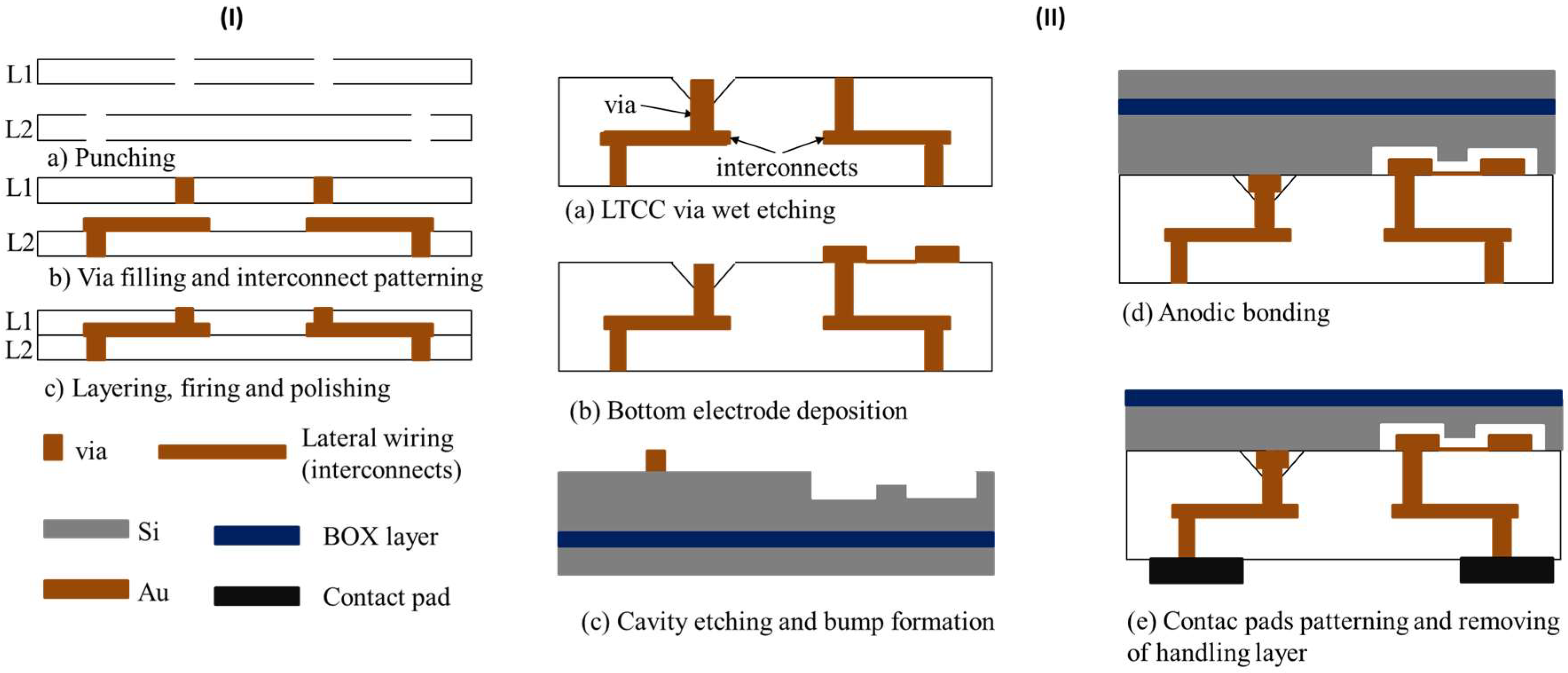
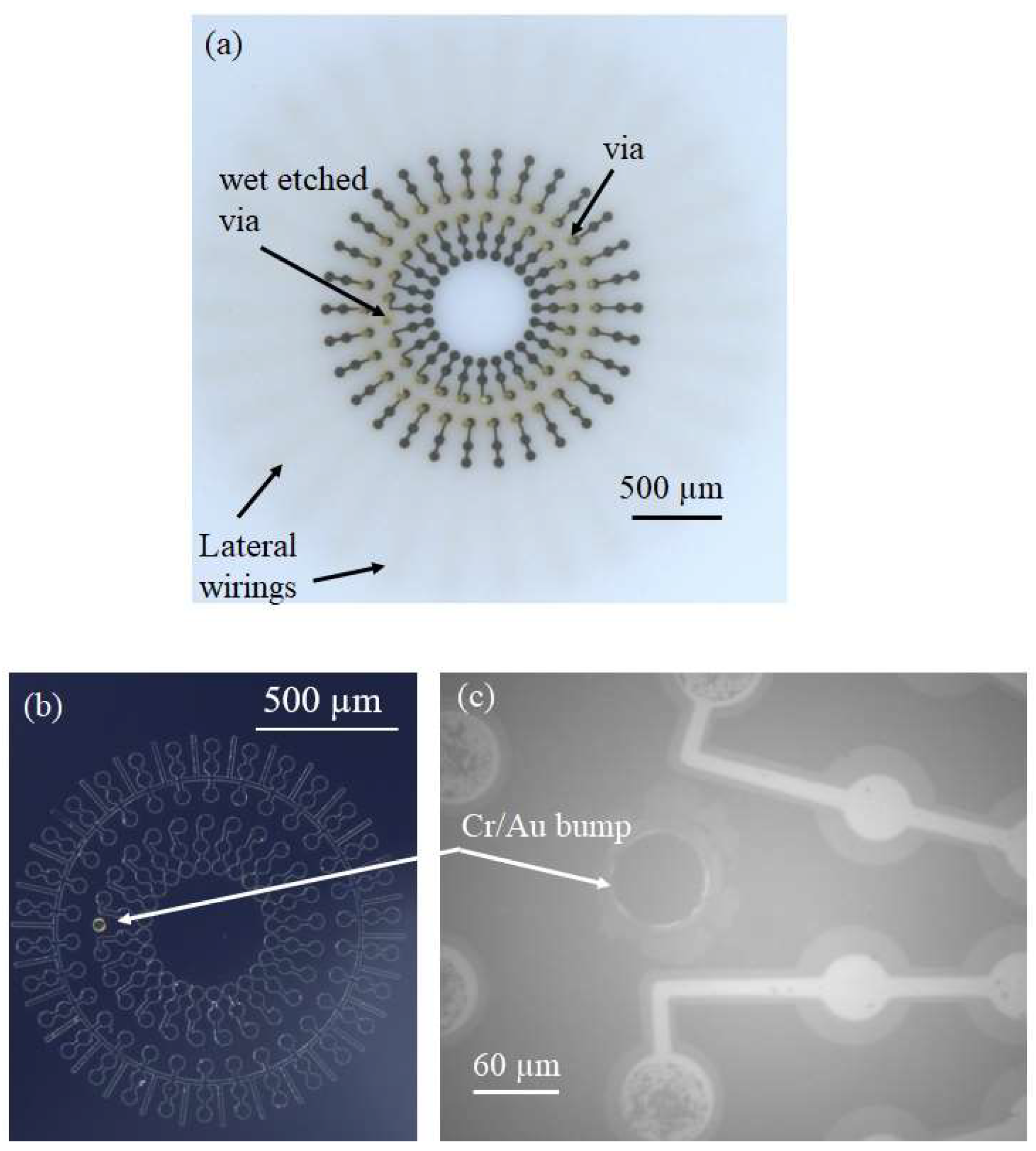
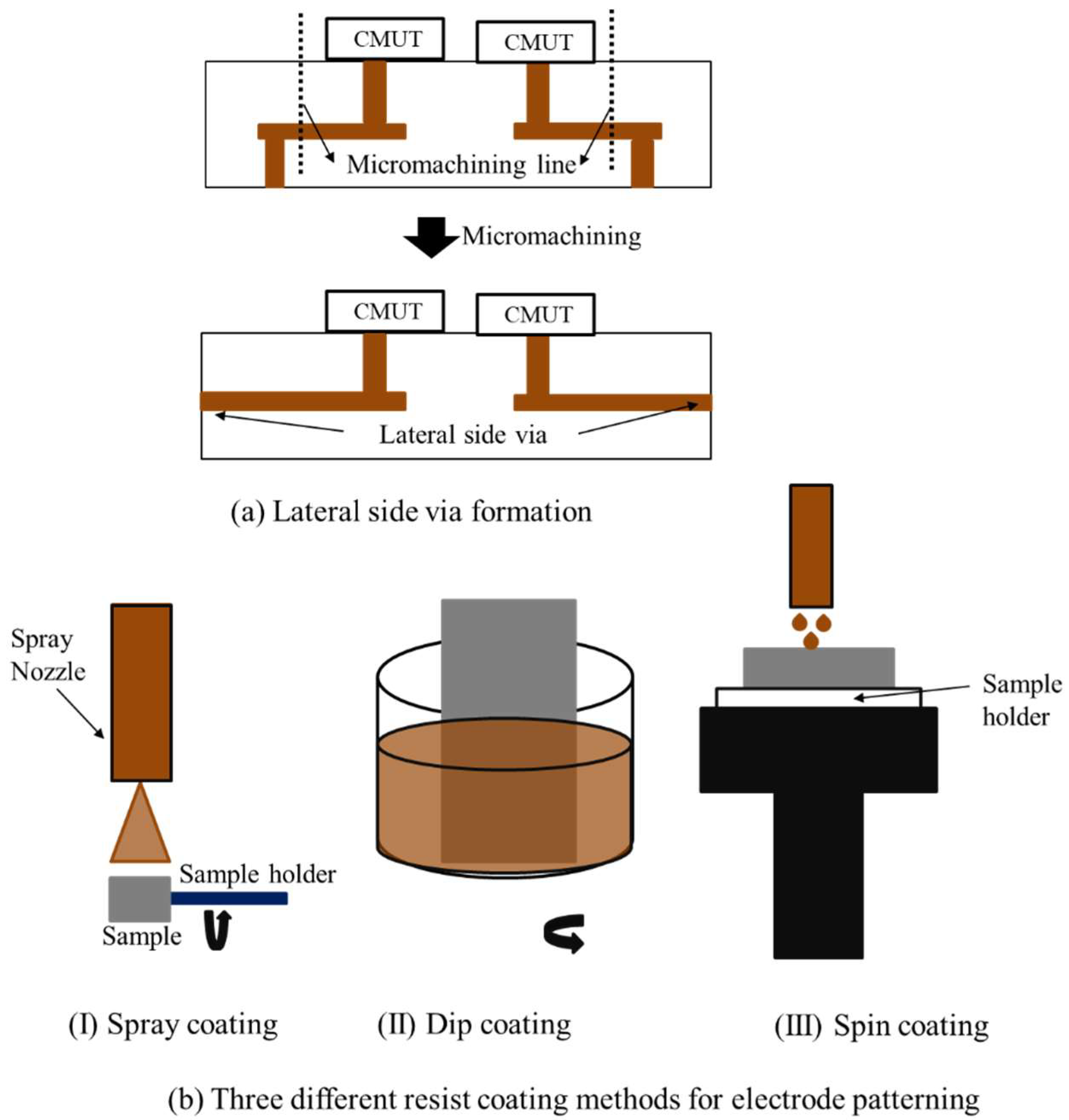

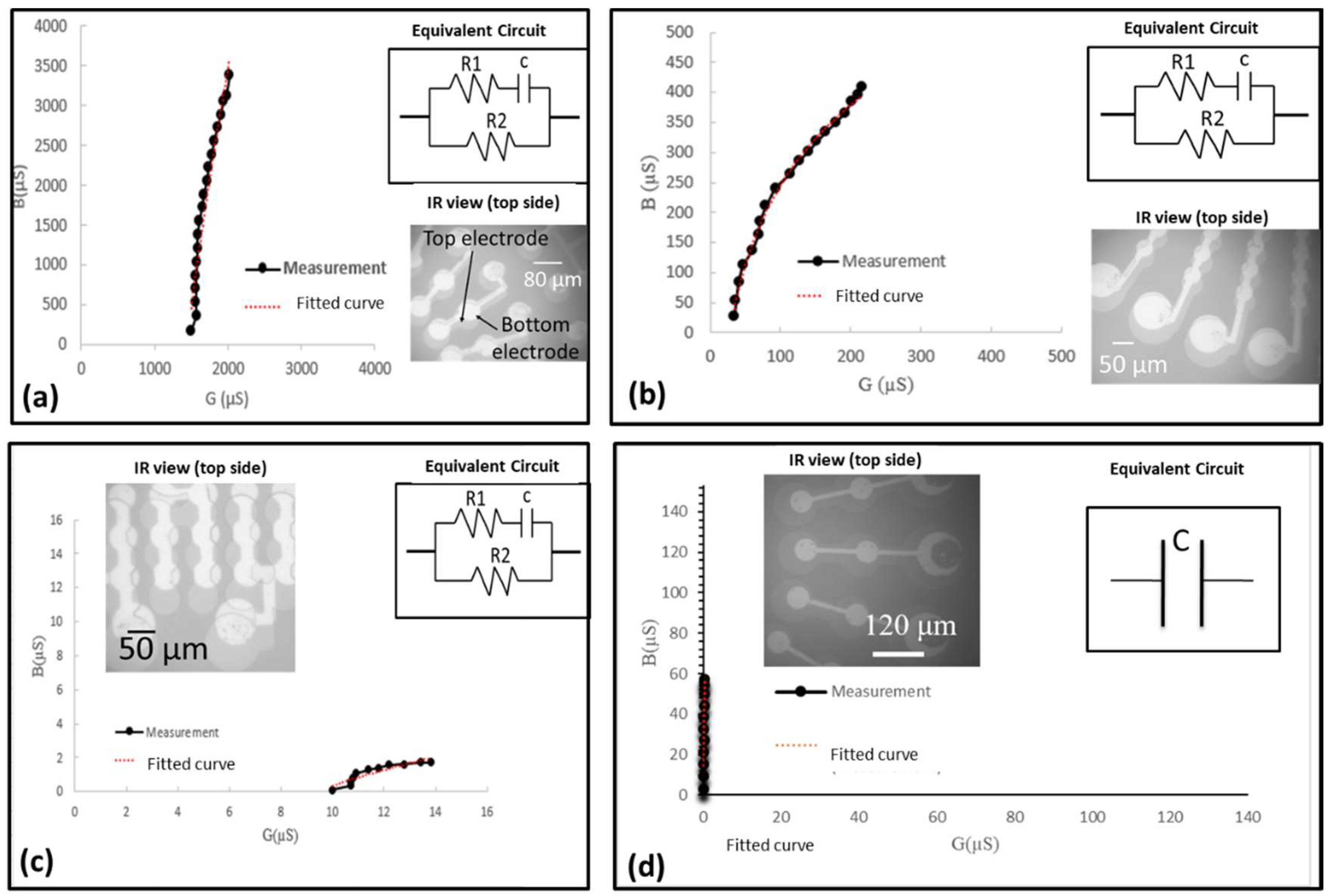

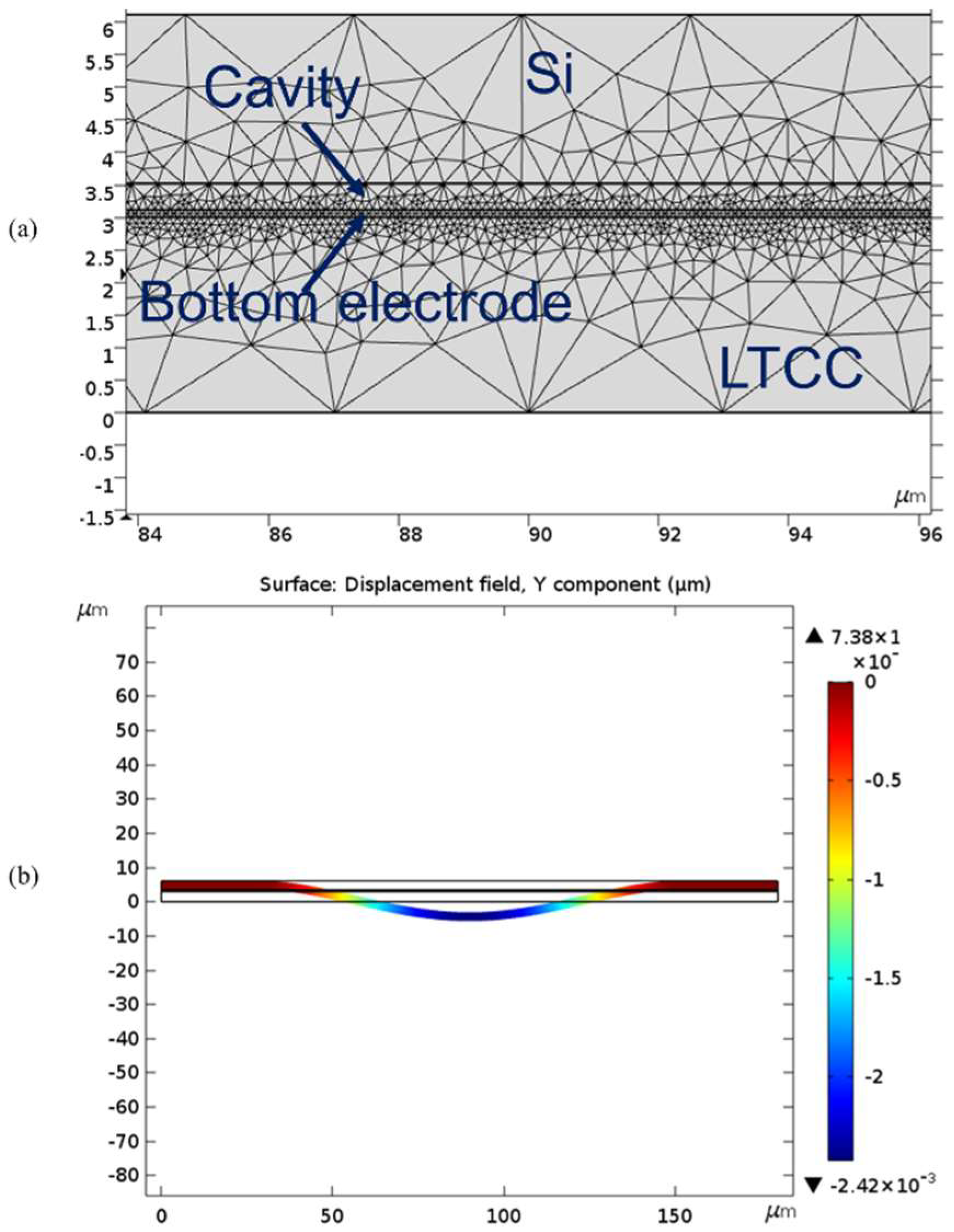
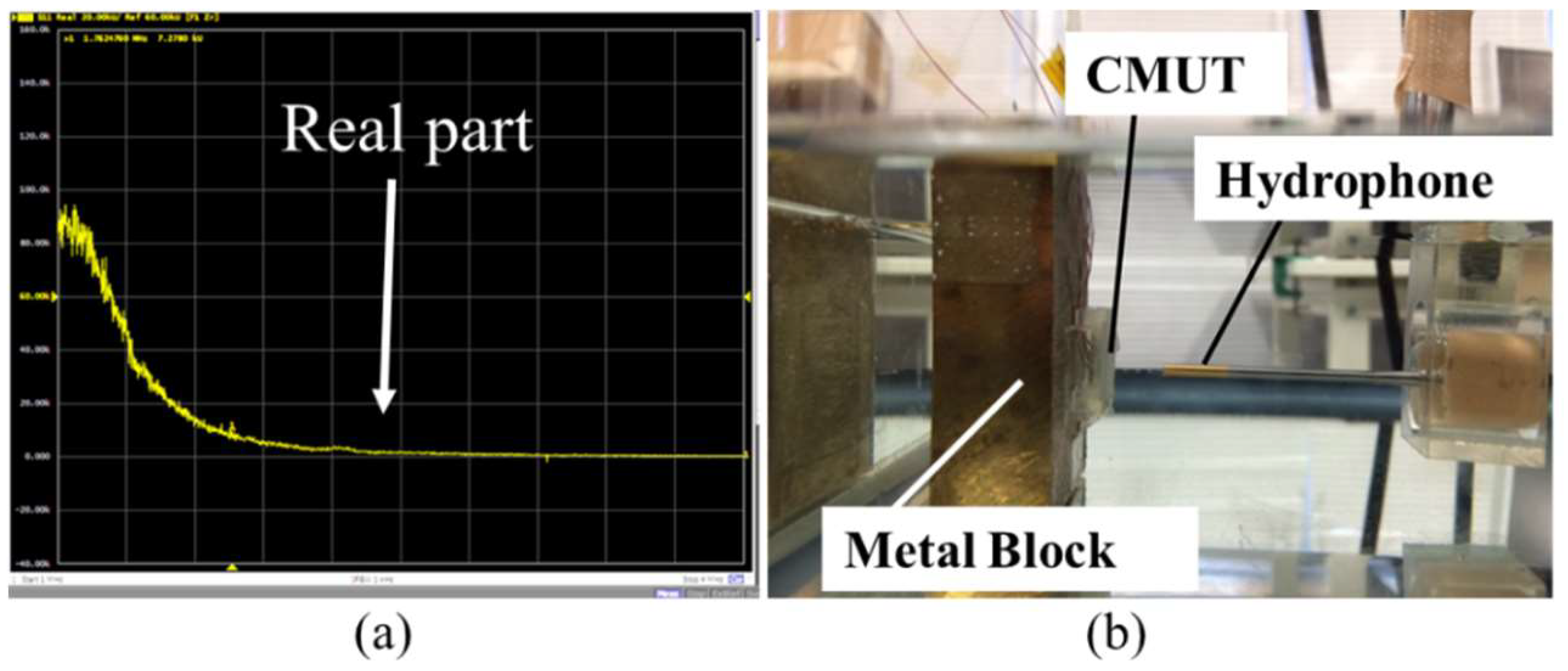
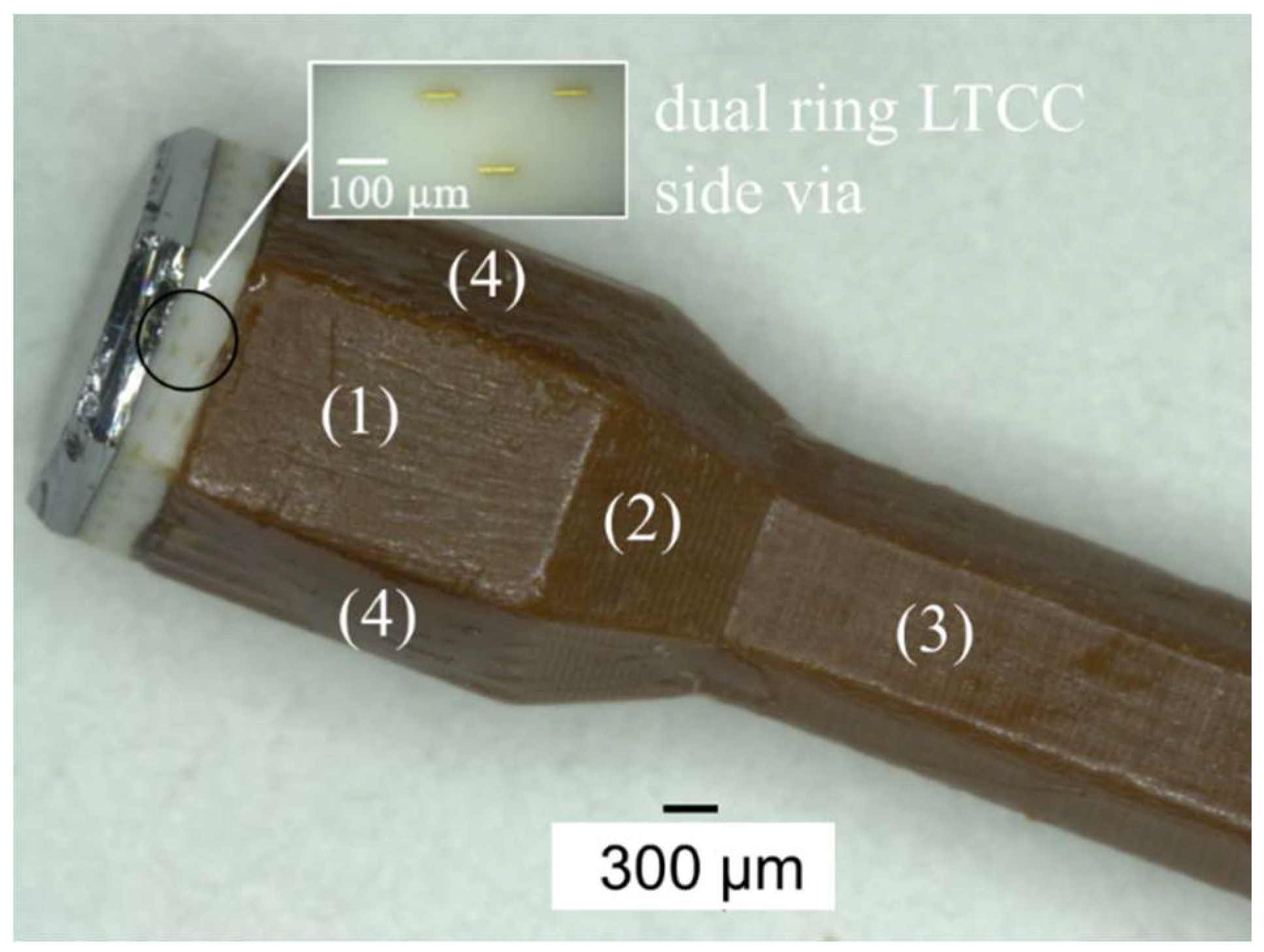
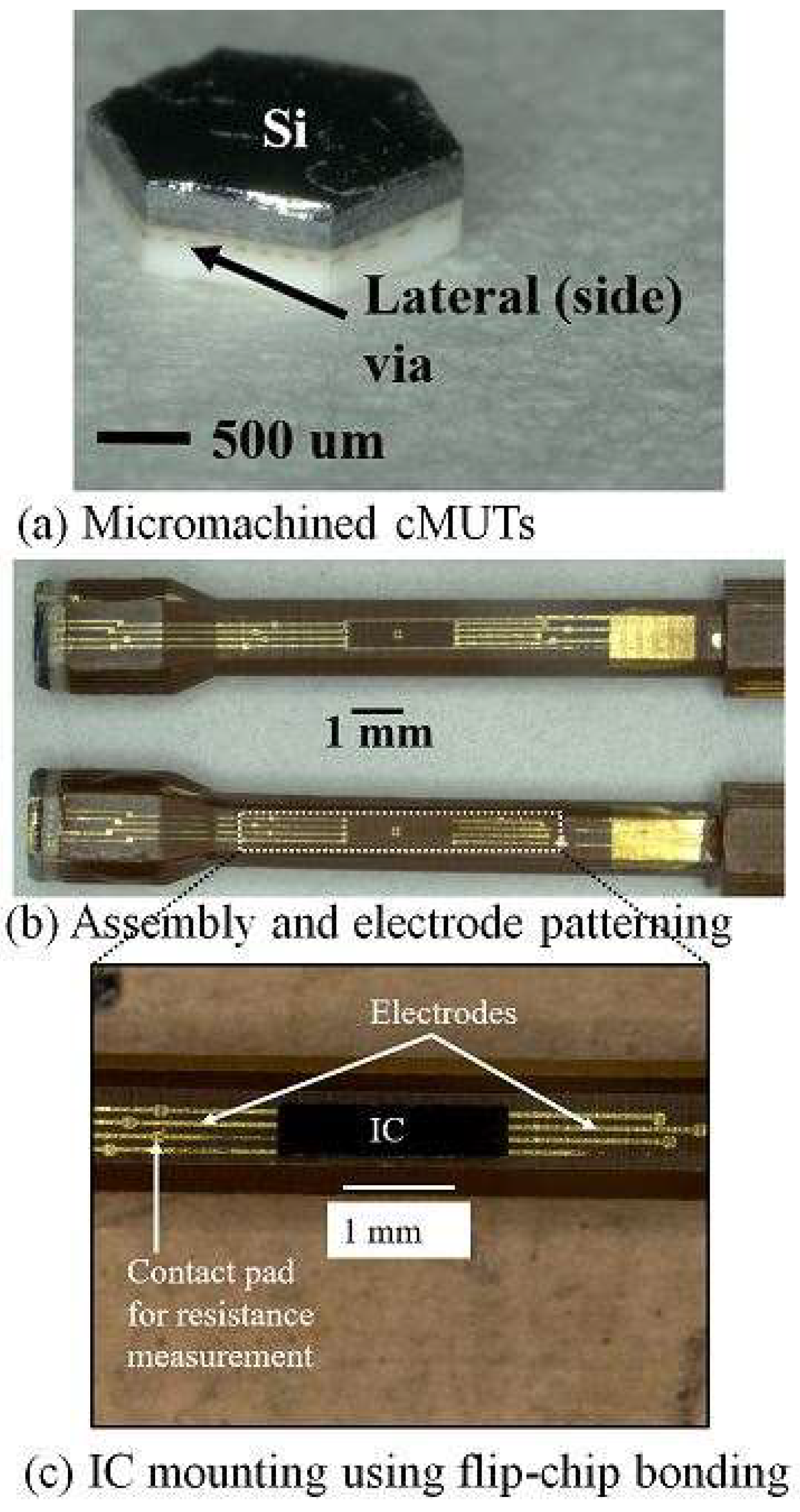
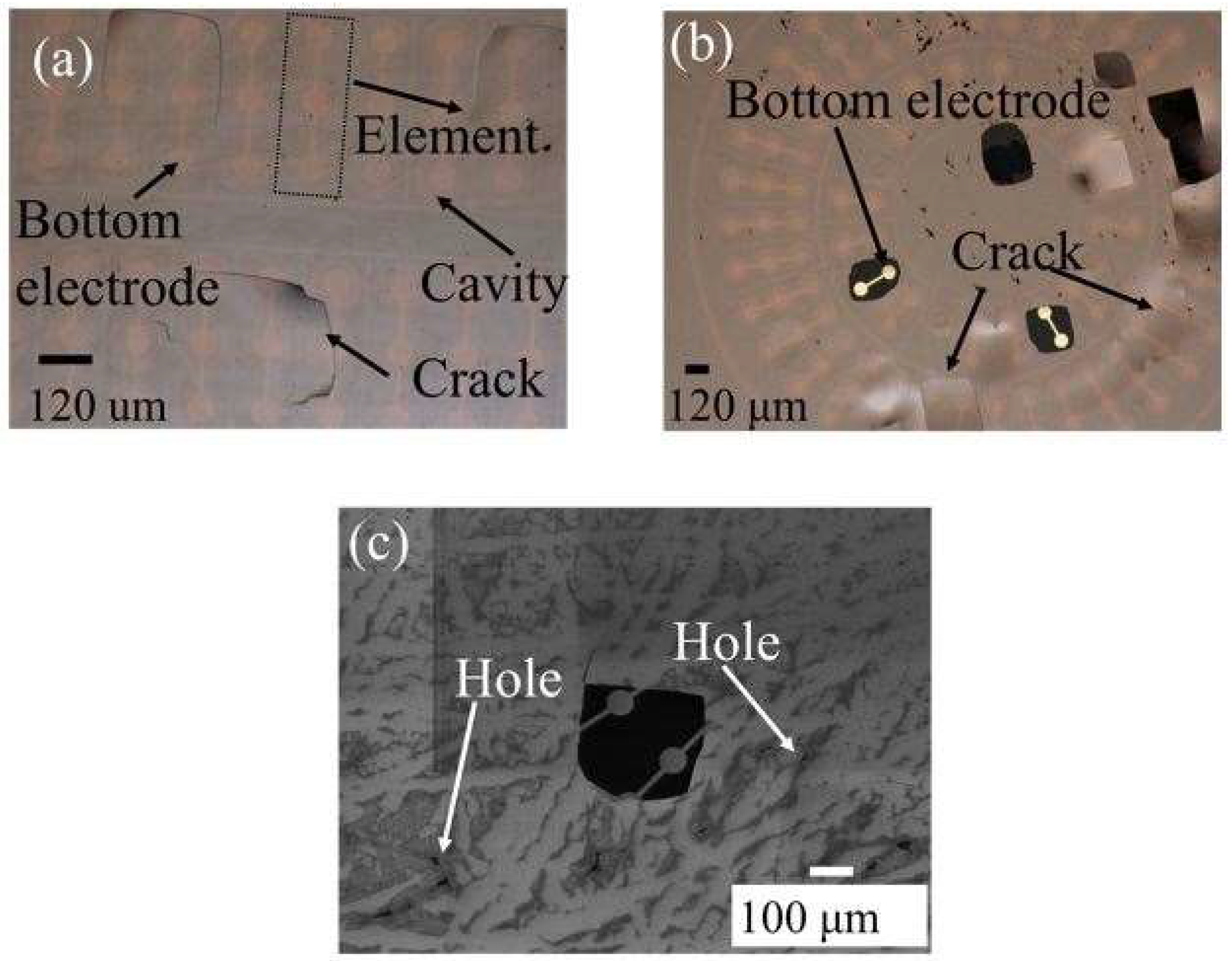
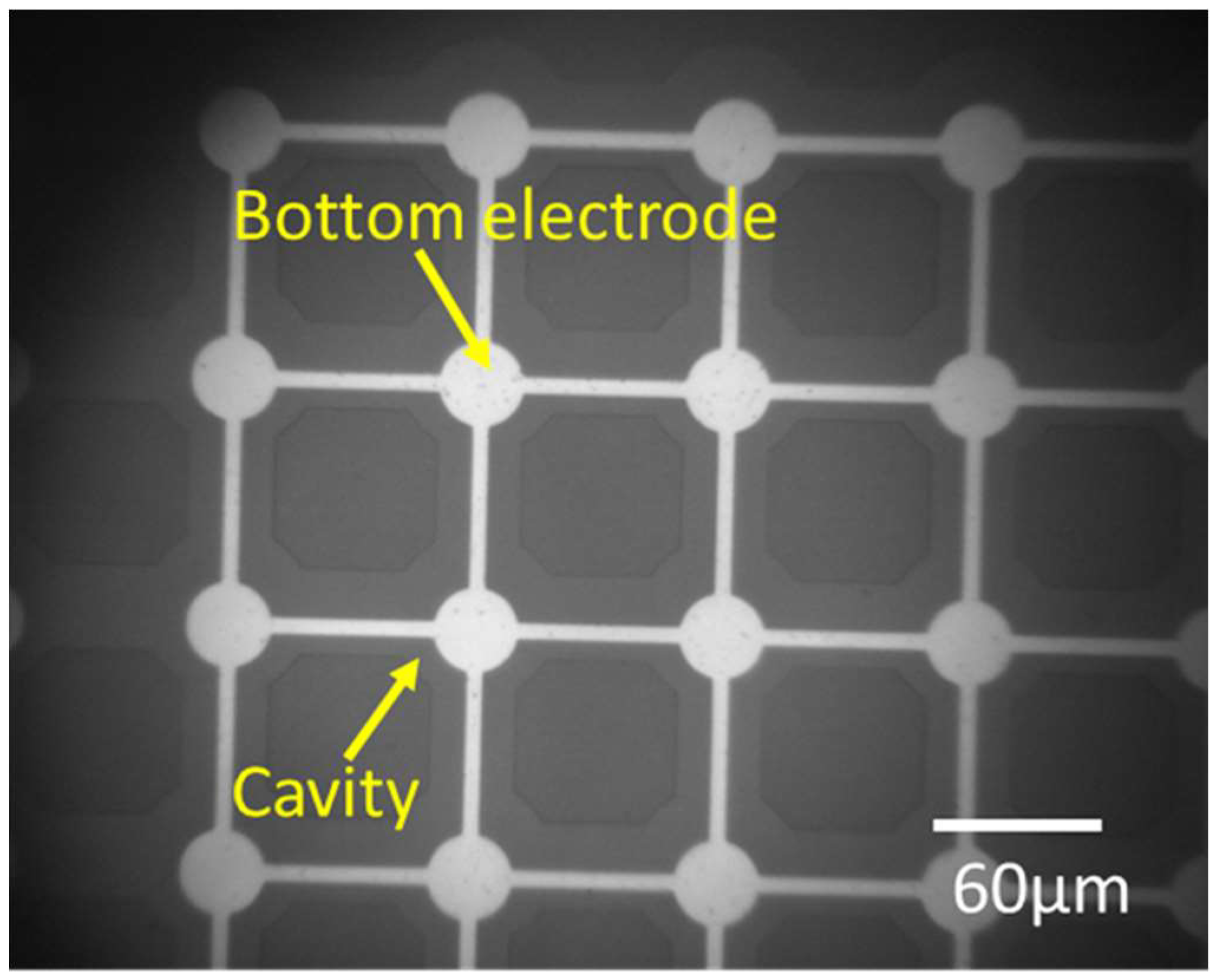

| Parameters | Value |
|---|---|
| Membrane diameter (µm) | 48, 50, 72, 80, 120 |
| Membrane thickness (µm) | 2.6 |
| Cavity depth (µm) | 0.4 |
| Electrode thickness (nm) | 120 |
| Number of elements | 25, 34, 54 |
© 2018 by the authors. Licensee MDPI, Basel, Switzerland. This article is an open access article distributed under the terms and conditions of the Creative Commons Attribution (CC BY) license (http://creativecommons.org/licenses/by/4.0/).
Share and Cite
Yildiz, F.; Matsunaga, T.; Haga, Y. Fabrication and Packaging of CMUT Using Low Temperature Co-Fired Ceramic. Micromachines 2018, 9, 553. https://doi.org/10.3390/mi9110553
Yildiz F, Matsunaga T, Haga Y. Fabrication and Packaging of CMUT Using Low Temperature Co-Fired Ceramic. Micromachines. 2018; 9(11):553. https://doi.org/10.3390/mi9110553
Chicago/Turabian StyleYildiz, Fikret, Tadao Matsunaga, and Yoichi Haga. 2018. "Fabrication and Packaging of CMUT Using Low Temperature Co-Fired Ceramic" Micromachines 9, no. 11: 553. https://doi.org/10.3390/mi9110553




